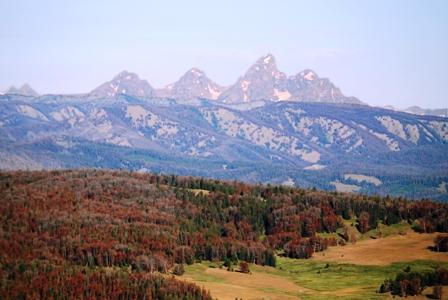U.S. Fish and Wildlife Service officials announced Tuesday that the agency will take a longer, more extensive look at whether whitebark pine trees, a key food source for some grizzly bear populations as well as birds and squirrels, need protection under the Endangered Species Act.
In a notice published in the Federal Register the agency acknowledged that substantial scientific and commercial information indicates that such a listing is merited.
Whitebark pines are a member of the "stone" pine family. It grows in the very highest reaches of Yellowstone, Glacier, Rocky Mountain, Yosemite, Sequoia and Kings Canyon national parks. These high-elevation trees produce a calorie-rich nut that grizzly bears in the greater Yellowstone ecosystem like to feast on in the fall. It's a nut that also feeds red squirrels and the Clark's nutcracker.
The sheer stature of the tree also helps maintain watersheds. In winter its bulk serves as natural snow fences, and in spring that same bulk helps shield the resulting snowbanks from the sun, thus allowing for a relatively slow and even snow melt.
Scientists regard the tree as a “foundation species” because it creates the conditions necessary for other plants and animals to get established in harsh alpine ecosystems. But the tree is in danger these days from non-native diseases, such as blister rust, and insects such as the mountain pine beetle, which are beginning to flourish in the trees' habitat thanks to climate change.
Back in February the Natural Resource Defense Council sued the Fish and Wildlife Service for failing to act on a year-old request that ESA protection be bestowed on the pines. At that time, Louisa Willcox, NRDC's senior wildlife advocate based in Montana, said that "What happens to whitebark pine will have sweeping effects on the entire high mountain forest ecosystems of the Northern Rockies. Of particular concern is the future of Yellowstone’s threatened grizzly population, which relies on the high-fat seeds of whitebark pine as a primary food source. Fewer whitebark pine seeds lead to higher numbers of grizzly bear deaths and lower reproductive success among females.”
The rate of the whitebark pine tree’s disappearance has increased significantly in recent years and raised concern from the scientific community, according to NRDC.
Under its announcement Tuesday, the Fish and Wildlife Service agreed to conduct a year-long review of scientific and commercial information on the species. Here is a summary of the ruling:
We, the U.S. Fish and Wildlife Service, announce a 90-day finding on a petition to list Pinus albicaulis (whitebark pine) as endangered or threatened under the Endangered Species Act of 1973, as amended and to designate critical habitat. Based on our review, we find that the petition presents substantial scientific or commercial information indicating that listing P. albicaulis may be warranted. Therefore, with the publication of this notice, we are initiating a review of the status of the species to determine if listing P. albicaulis is warranted. To ensure that this status review is comprehensive, we are requesting scientific and commercial data and other information regarding this species. Based on the status review, we will issue a 12-month finding on the petition, which will address whether the petitioned action is warranted, as provided in section 4(b)(3)(B) of the Act.




Comments
Anonymous,
Since David nor Sylvia replied to your question I'll take a stab at it.
First, historical winter temperatures in whitebark pine habitats were frequently cold enough to kill all mountain pine beetle life stages everywhere but in the most protected sites, for example in the tree bole beneath the insulating snow cover. Second, summer temperatures typically did not provide enough heat increment to complete an entire life cycle in one year (univoltineism). The combination of cold temperature, winter mortality, and cool summer temperatures served to keep mountain pine beetle populations in check. With the advent of a warming climate: (1) winter temperatures have become mild enough to allow substantial overwinter survival of all life stages; and (2) there is sufficient summer thermal energy to complete an entire life cycle in one year. Historically, the simultaneous occurrence of these necessary conditions occurred only infrequently in high elevation whitebark pine forests. And when this did occur in the 1930’s and 1970’s it was short-lived only lasting a couple of seasons, at most.
With the advent of anthropocentric global warming in the past few decades, the ecological relationship between mountain pine beetle and whitebark pine has undergone a fundamental shift. We now consistently observe large numbers of successfully attacked whitebark pine trees in late spring/early summer. Apparently, re-emerging parent adults from the previous summer, perhaps augmented by an early phase emergence of new brood adults, are responsible for this mortality. Winters are becoming mild enough that even adult beetles, a freeze intolerant stage, are surviving. These surviving beetles, at even relatively low densities, have been able to successfully attack new whitebark pine trees. The shift from non-overlapping, semivoltine (life cycle requiring two years to complete) generations to overlapping, bi-modal, univoltine (life cycle completed in a single year) generations with a concomitant increase in reproductive potential. This shift I believe is being driven by climate change and not normal variation in weather conditions.
Also consider the effects of high elevation snowmobiling to young whitebark pines, some cannot be seen under the snow....